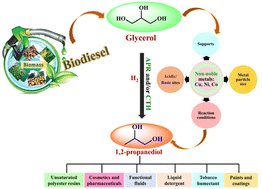A review on non-noble metal catalysts for glycerol hydrodeoxygenation to 1,2-propanediol with and without external hydrogen
Abstract
The depleting petroleum oil resources, political embargos, and global warming dilemma have made it mandatory to develop alternative green technologies for energy and chemical production. Glycerol is one of the top-12 building block chemicals that can be mainly obtained as a coproduct of biodiesel production. The value addition of glycerol is only possible through its conversion to commodity and fine chemicals. Glycerol hydrogenolysis is one of the crucial pathways to produce several value-added products, among which 1,2-propanediol (1,2-PDO), 1,3-propanediol (1,3-PDO), ethylene glycol (EG) and 1-and/or 2-propanols are hydrogenolysis products. Selective glycerol hydrogenolysis to the desired product 1,2-PDO is only possible through the catalyst having an optimum combination of acid/base and metal sites (metallic and mixed oxides). The present review mainly focuses on the critical assessment of the influence of different supports, catalyst preparation methods, and/or pretreatment on structural, and electronic properties and simultaneously on the activity and product selectivity of non-noble metal catalysts. The role of reaction parameters in this industrially important reaction on catalyst performance will also be presented. A rigorous survey of patented literature on non-noble metal-catalyzed glycerol hydrogenolysis to 1,2-PDO is also discussed. Further, the review covers recent progress on non-noble metal-catalyzed autogenous glycerol hydrogenolysis through glycerol aqueous phase reforming (APR) and/or catalytic transfer hydrogenolysis (CTH), to overcome the cost and handling issues of external hydrogen. Finally, techno-economic analysis is also presented which compares the glycerol hydrogenolysis with and without external hydrogen with the conventional process of 1,2-PDO production. This analysis indicated that CTH and glycerol hydrogenolysis under ambient hydrogen pressure have the potential for commercialization, however catalyst stability and elimination of co-product formation at higher glycerol concentration need to be considered critically.

- This article is part of the themed collection: Green Chemistry Reviews


 Please wait while we load your content...
Please wait while we load your content...